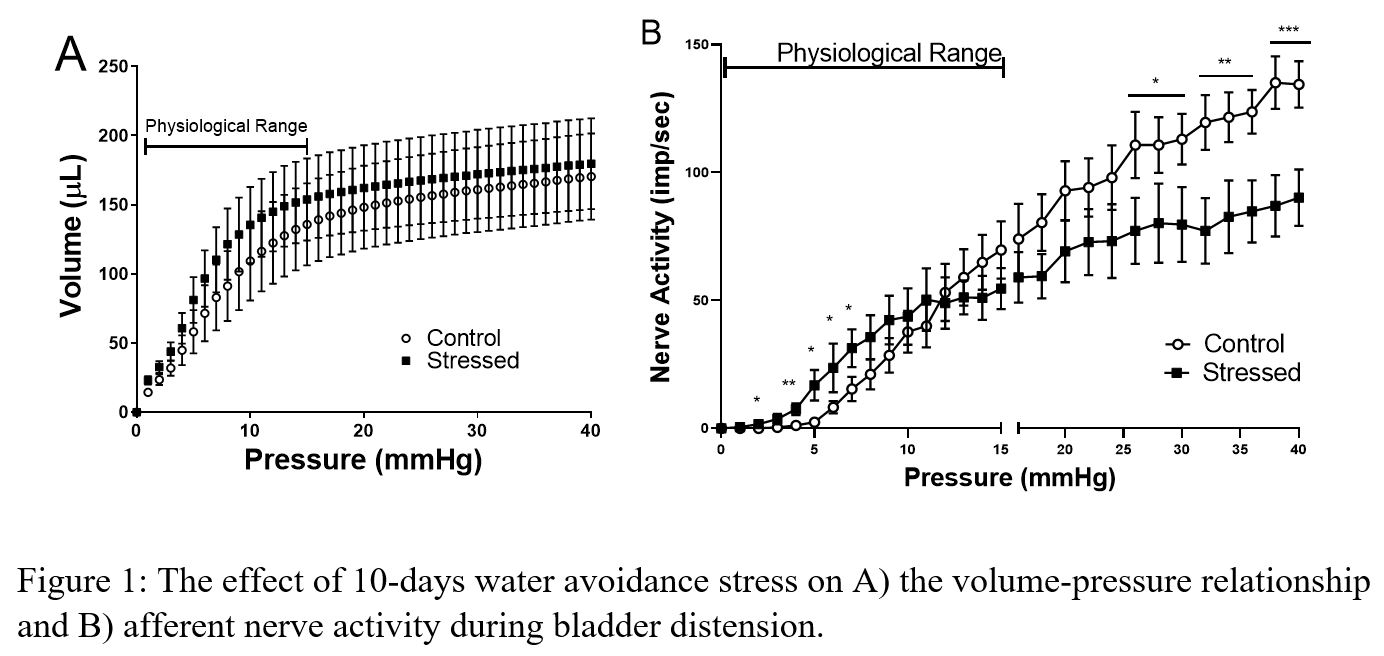Recent experimental evidence shows that bladder overactivity occurs in female mice following water avoidance stress exposure, with accompanying alterations in detrusor contractile responses (West et al, 2021). The storage and micturition reflexes of the bladder are controlled by information from the afferent nerves and changes in their activity known to result in bladder dysfunction. Stress has been shown to affect activity of the afferent nerves in the gut (Yu et al, 2010) and it has been postulated that similar sensitization may also occur in bladder afferents, explaining the overactive voiding phenotype seen in rodent models. However, to date there is no direct evidence to support this. Therefore, the aim of this study was to investigate the effects of water avoidance stress on bladder afferent nerve activity in response to distension (bladder filling) in mice. Adult (12-14 weeks) female C57BL/6J mice were allocated to either stress or control groups, (n=7 per group). Stressed animals were exposed to water avoidance stress (WAS) for 1hr/day for 10 days. Unstressed controls were age-matched and housed normally. Voiding behaviour was measured using void pattern analysis before starting and on completion of the WAS treatment period. Mice were sacrificed 24-h after final stress exposure and whole bladders isolated to measure afferent nerve activity and intravesical pressure during bladder distension. Data are presented as mean ± SEM and differences between control and stress groups were determined using unpaired Student’s t-test. Water avoidance stress caused bladder overactivity in adult female mice evident as an increase in urinary frequency from 6.7±1.5 in controls to 13.1±1.0 voids per 4 hour period in stressed mice (p=0.009), without change in urine output. As bladder volume increased, both intravesical pressure and afferent nerve activity increased (Figure 1A&B), with bladder compliance unaffected by stress. The afferent nerve activity recorded during bladder distensions was significantly increased after stress at low bladder pressures (2, 4-7mmHg) relevant to normal physiological filling (Figure 1B). While at higher pressures >25mmHg afferent nerve activity was significantly lower in stressed animals (Figure 1 B). The number of individual nerve fibres contributing to the nerve activity was similar between control and stressed groups and the ratio of low and high threshold nerves was also unchanged by stress. The low threshold nerves, responsible for filling sensations, were significantly more active in stressed animals at low pressure (5mmHg) (p<0.01), however at the higher pressures (35 and 40mmHg) the low threshold nerves in stressed animals were significantly less active than controls (p<0.05). The high threshold nerves, responsible for pain sensations, were more active in the stressed animals than in controls across all pressure points from 10-35mmHg (p<0.05). These results indicate that WAS causes enhanced activity of individual afferent nerve fibres in response to bladder distension. The enhanced activity was seen in both low and high threshold nerves suggesting that stressed animals may experience enhanced bladder filling sensations at lower bladder volumes as well as increased pain sensations, both potentially contributing to the increased urinary frequency seen after stress.
Physiology 2021 (2021) Proc Physiol Soc 48, OC56
Oral Communications: Psychological stress alters voiding behaviour and enhances activity in both low and high threshold bladder afferent nerves in female mice
Kylie Mills1, Eliza West1, Donna Sellers1, Russ Chess-Williams1, Catherine McDermott1
1 Centre for Urology Research, Bond University, Gold Coast, Australia
View other abstracts by:
Where applicable, experiments conform with Society ethical requirements.

